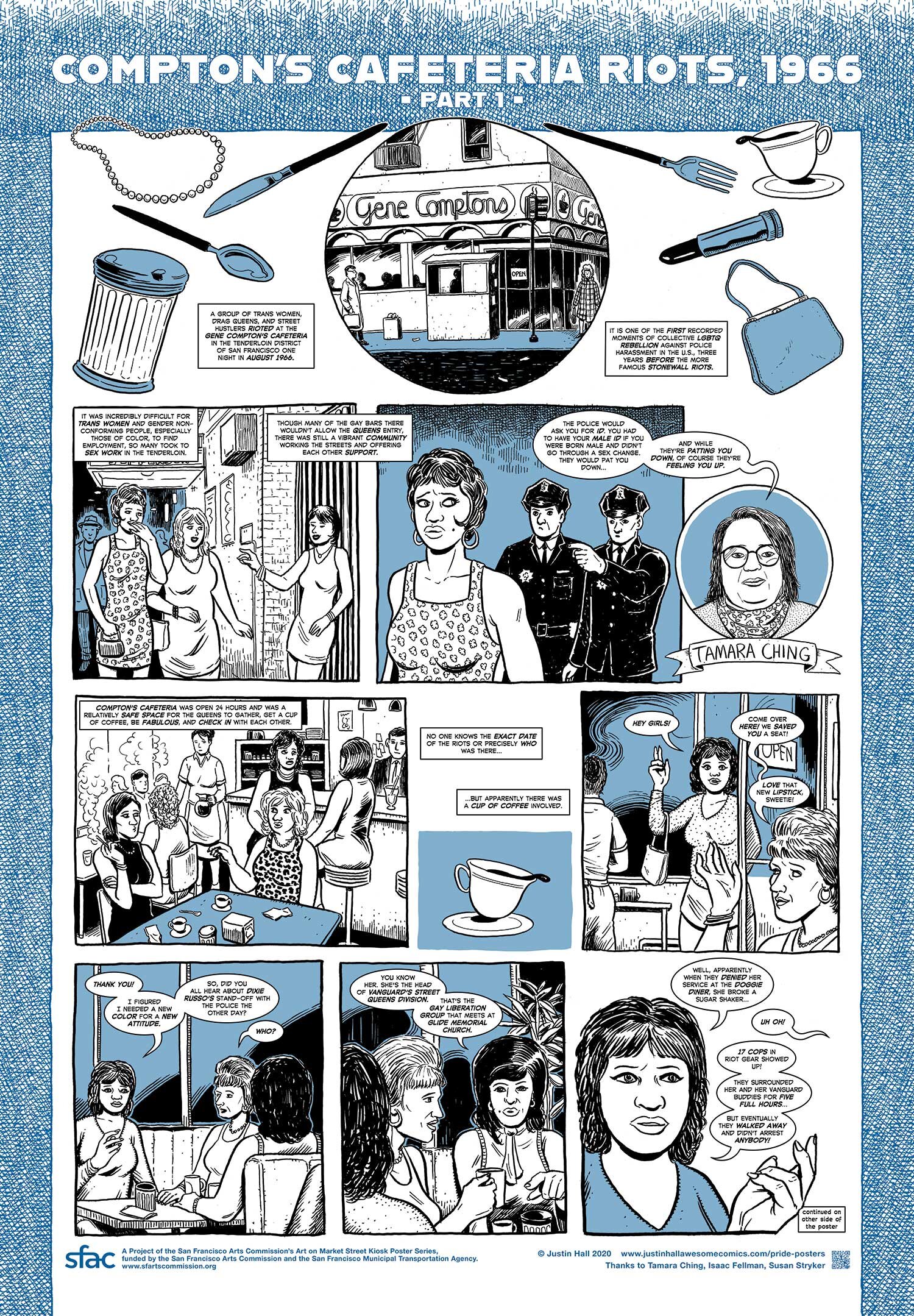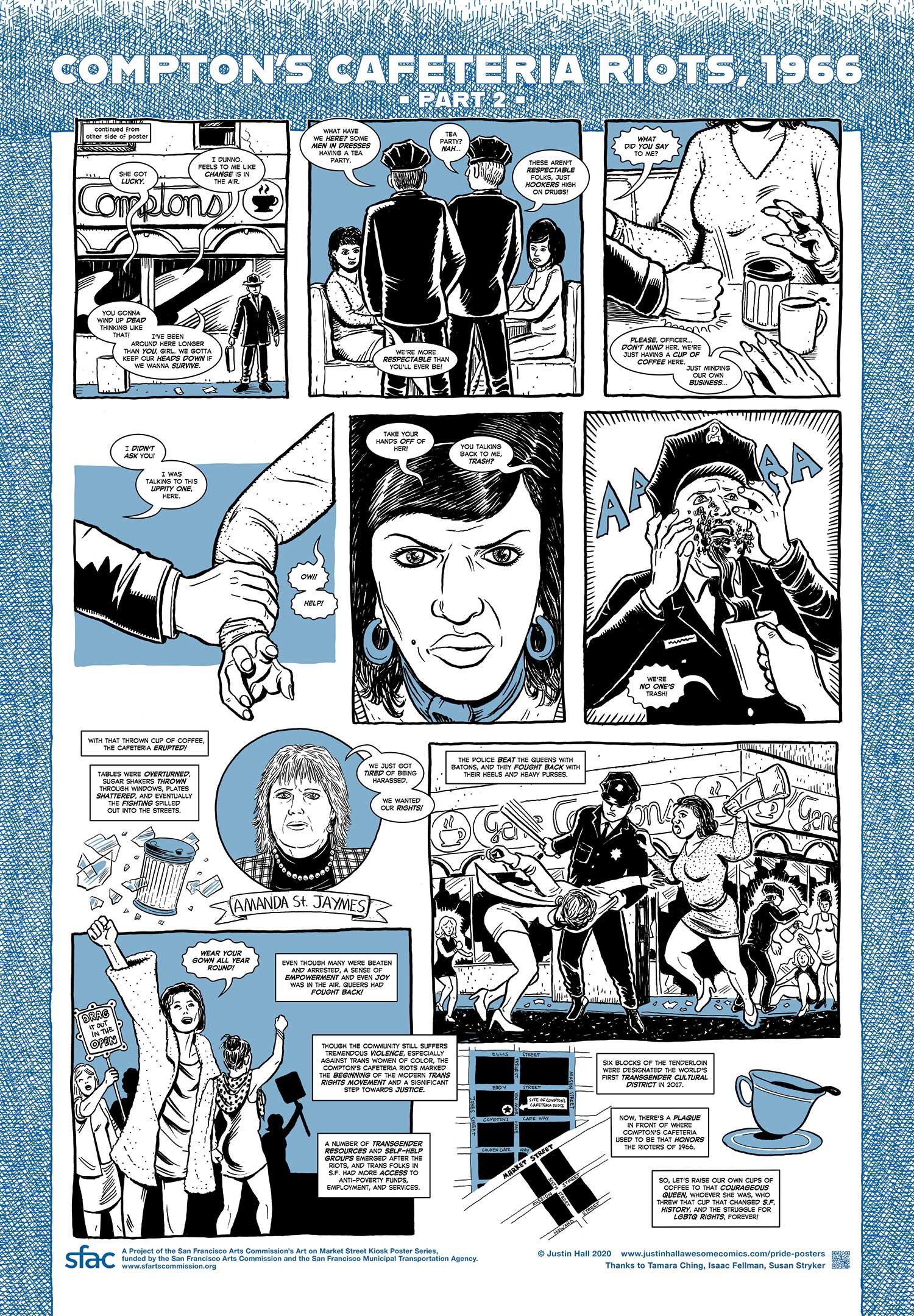Compton’s Cafeteria Riots, 1966
The fifth poster, blue to represent the fifth color on the rainbow flag, is COMPTON’S CAFETERIA RIOTS, 1966. This comic illustrates the riots that helped begin the modern trans rights movement and galvanized the larger LGBTQ civil-rights struggle three years before Stonewall.
This moment was almost forgotten until recently. The pioneering historian Susan Stryker unearthed the story of the riots in documents at the GLBT Historical Society and through interviewing the people involved. Then, with Victor Silverman, she co-wrote and co-directed the film Screaming Queens: The Riot at Compton’s Cafeteria about the incident.
Stryker graciously looked over this comic and did some fact-checking; then she put me in touch with Tamara Ching, who was part of the Tenderloin scene during the 1960s and has been in the Polk Street area fighting for trans rights, sex-workers’ rights, and HIV/AIDS justice for decades. She also reviewed my script and final drawings.
I’m also indebted to Isaac Fellman of the GLBT Historical Society for his fact-checking. He noted that the now-iconic photo of drag activists carrying the sign “drag it out in the open,” which inspired my illustration at the bottom left of the second side of the poster, is not from the Compton’s Cafeteria Riots, which I had mistakenly believed.
That photo, credited to Bil Paul, is actually from a demonstration by the Gay Guerrilla Theater and Gay Liberation Coalition at the Beaux Arts Ball during the Halloween season of 1969. During that era, Halloween and New Year’s Eve were the only times during the year that “cross-dressing” was allowed by the San Francisco police; otherwise, dressing in drag, or in the clothing of the gender you weren’t assigned at birth, could land you in jail. These activists were picketing the gay establishment Tavern Guild, which was hosting the ball, for buying into this idea of allowing “crossdressing” only during these specific dates and for not allowing it in many of their bars otherwise.
Since the text in the panel describes how the riots helped catalyze a wave of trans and LGBTQ activism, I kept the image, even though it wasn’t from the Compton’s Cafeteria Riots. I added the “Wear your gown all year round!” slogan of the Beaux Arts demonstration to provide more context. This link will take you to the article in the Berkeley Tribe in which the photo appeared. Coincidentally enough, it’s written by Leo Laurence, who shows up in my SAN FRANCISCO PRIDE, 1970 poster as one of the founders of the first SF Pride march.
No one knows who actually threw the cup of coffee that started the riots, which is why much of this poster is historical fiction. Some think it might have been Dixie Russo, who was involved in the earlier incident at the Doggie Diner that the queens discuss in this poster. She was a member of the group Vanguard, which demonstrated in the Tenderloin and was connected to Glide Memorial Church (a venerated site of LGBTQ activism and other progressive causes and the home of the CRH, the focus of my poster COUNCIL ON RELIGION AND THE HOMOSEXUAL, 1964). Vanguard is often referred to as the first Gay Liberation group, differentiating it from the homophile movement I portray in the DAUGHTERS OF BILITIS, 1955, poster.
LGBTQ terminologies and identities have evolved radically since the 1960s. The people who rose up in the Tenderloin in 1966 would not have referred to themselves with the same language we do now, as terms such as “gender-nonconforming,” “non-binary,” or even “transgender” didn’t yet exist or weren’t in common usage. However, I used mostly modern terms in this poster in order to avoid confusion.
Finally, please check out The Transgender District, the world’s first designated trans cultural district; they are doing remarkable work to keep the legacy of the riots alive. Also, the Tenderloin Museum sponsored an original, interactive theatrical production of Compton’s Cafeteria Riots, conceived of and written by Mark Nassar, Katie Conrie, and the legendary neighborhood queens Donna Persona and Collette LeGrande. When the pandemic is over, the show is a must-see for anyone interested in this history.



